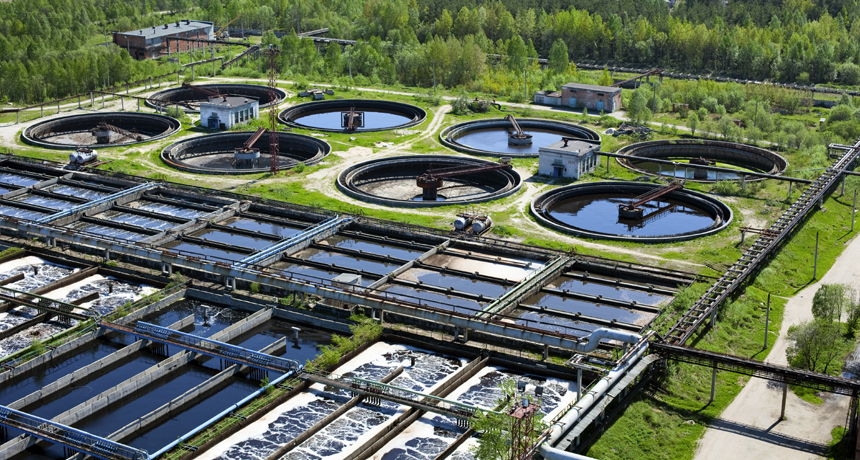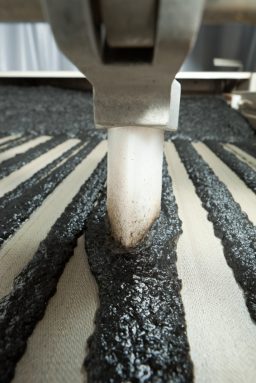How a germ killer could backfire
An ingredient in many household products can cripple the helpful microbes in a town’s water-treatment plant

Wastewater treatment plants, like the one shown, use bacteria to treat sewage. But a germ-killing chemical in some household products can harm those helpful bacteria.
antikainen/iStockphoto
Kitchen sponges, hand soaps and toothpaste are among common household products that may include triclosan, a chemical to kill germs. On hands and around the home, it can prevent infections. But once that germ killer washes down the drain, it can become a menace. A new study finds that the chemical can thwart the process of cleaning sewage. That’s the dirty water flushed down toilets or washed down the drains of sinks.
Some bacteria thrive on sewage. They digest some of it and produce a gas called methane. Wastewater treatment plants use these bacteria to help treat sewage. When the bacteria have had their fill, the once-toxic waste has been turned into a material that is safe enough to be used elsewhere. The solid waste, or sludge, from many treatment plants is actually recycled as a fertilizer. But that’s a good idea only if the carbon-rich materials in the sludge have been broken down into simpler nutrients by the bacteria.
The problem
Triclosan is an antimicrobial. That means it kills bacteria and other germs. When people use products containing triclosan, some of the chemical will end up going down the drain. It will eventually enter the facilities that cities build to clean sewage and other forms of wastewater.
At waste treatment plants, helpful bacteria digest — break down — the wastes in that water. So do archaea, another type of microbe. Once these microbes have done their work, the sludge smells better and is safer for people to use. As the microbes break down sewage, they release a gas called methane. Civil engineers who monitor the treatment plants can track the breakdown of waste by measuring how much methane they have released.

They gathered bacteria that had already been exposed to triclosan at water-treatment plants. Then the scientists fed triclosan-rich sludge to these microbes. They compared the how much methane the microbes produced compared to bacteria that had never been exposed to triclosan.
Some microbes got to nibble at sludge containing triclosan at a low concentration of 5 parts per million. That’s about the level found in sludge from many water-treatment plants. These bacteria produced as much methane as bacteria that had no exposure to triclosan.
But at a high concentration of triclosan, 50 parts per million (an amount found in 5 percent or less of sewage sludges), the microbes’ methane levels varied from high to low. That suggested this high level of triclosan was “a tipping point.” Some microbial communities failed to function in the presence of that much triclosan, the authors say. And at 500 parts per million (four times the highest level seen in any sludge), the bacteria produced less than half as much methane as bacteria with no exposure to triclosan. So less waste breakdown was occurring.
McNamara told Science News he wasn’t surprised. After all, antimicrobials kill germs no matter where they’re found.
Right now, the only way to lower the amount of triclosan in treatment plants is for people to use less of the chemical.
The new findings should encourage the government to pay attention to the risk antimicrobials may have on water-cleanup processes Rolf Halden told Science News. Halden is a civil engineer at Arizona State University in Tempe. He did not work on the study.
Limiting how much of these chemicals get into wastewater, he says, “should be a priority for the nation.”
Power Words
antimicrobial A substance used to kill or inhibit the growth of microbes. Manufacturers have added some, such as triclosan and triclocarban, to sponges, soaps and other household products.
archaea (singular, archaeon ) A domain of life that includes single-celled organisms. Although archaea superficially resemble bacteria, they are distinct. Archaea inhabit many harsh environments.
bacterium (plural bacteria) A single-celled organism forming one of the three domains of life. These dwell nearly everywhere on Earth, from the bottom of the sea to inside animals.
civil engineer An engineer who creates buildings, tunnels, water systems and other large projects that improve everyday life.
fertilizer Nitrogen and other plant nutrients added to soil, water or foliage to boost crop growth or to replenish nutrients that removed earlier by plant roots or leaves.
germ Any one-celled microorganism, such as a bacterium, fungal species or virus particle. Some germs cause disease. Others can promote the health of higher-order organisms, including birds and mammals. The health effects of most germs, however, remain unknown.
methane A hydrocarbon with the chemical formula CH4 (meaning there are four hydrogen atoms bound to one carbon atom). It’s a natural constituent of what’s known as natural gas. It’s also emitted by decomposing plant material in wetlands and is belched out by cows and other ruminant livestock. From a climate perspective, methane is 20 times more potent than carbon dioxide is in trapping heat in Earth’s atmosphere, making it a very important greenhouse gas.
microbe Short formicroorganism. (see microorganism)
microorganism A living thing that is too small to see with the unaided eye, including bacteria, some fungi and many other organisms such as amoebas. Most consist of a single cell.
parts per (million, billion or trillion) A measurement of extremely small concentrations of one chemical dissolved in another. For example, a solution of 300 parts per billion of sodium in water would mean that there are 300 sodium atoms for every billion water molecules.
sanitize The process of removing substances that can spread disease.
sewage Wastes — primarily urine and feces — that are mixed with water and flushed away from homes through a system of pipes for disposal in the environment (sometimes after being treated in a big water-treatment plant).
triclosan A germ-killing chemical added to some common products such as hand soaps and sponges.
wastewater Any water that has been used for some purpose (such as cleaning) and no longer is clean or safe enough for use without some type of treatment. Examples include the water that goes down the kitchen sink or bathtub or water that has been used in manufacturing some product, such as a dyed fabric.







